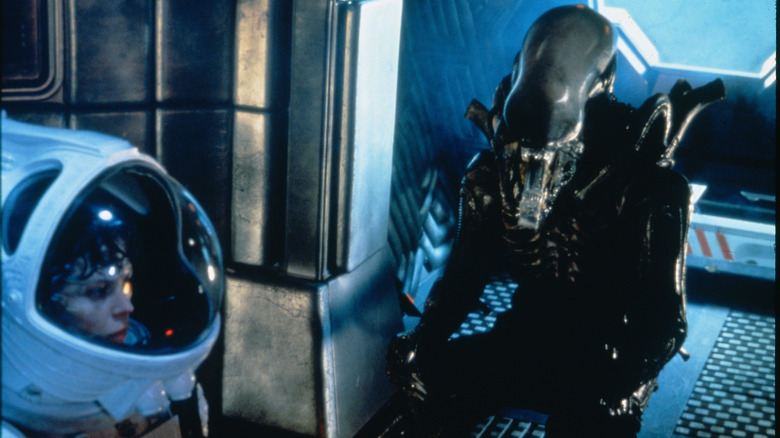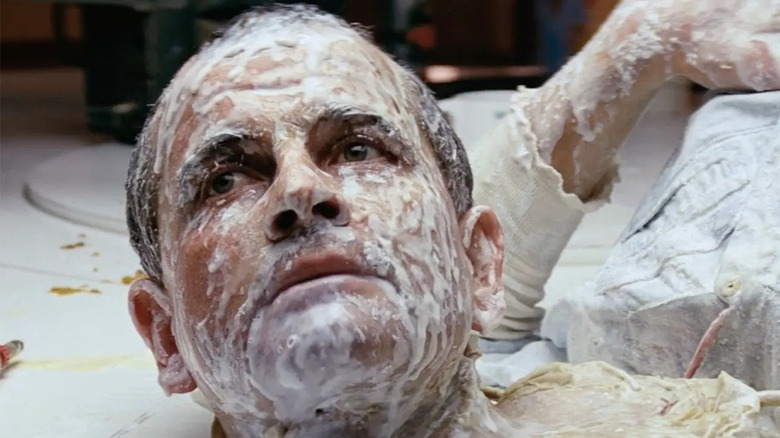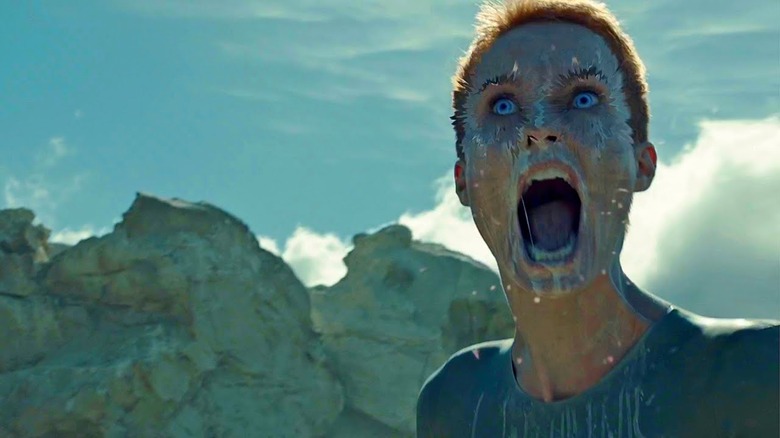How An Experiment On The Alien Set Became One Of Ridley Scott's Weirdest Calling Cards
It is not uncommon for film directors to have calling cards in their movies, like personal homages or the use of a specific style. Examples include the recurring fake movie in John Landis films or James Cameron's use of the color blue. When it comes to science fiction, director Ridley Scott is considered one of the masters. He didn't invent the horror/sci-fi genre, but many believe he perfected it. His 1979 film "Alien" introduced audiences to a terrifying vision of life from other planets. And it also gave him a signature calling card.
"Alien" is iconic for multiple reasons. It perfectly blends the horror and sci-fi genres. "Alien" went against the grain with the iconic, kick-ass female protagonist Ripley (Sigourney Weaver). It introduced nightmare-inducing antagonists such as face-hugging parasites and the perfect killing machine Xenomorph, described in the film as, "structural perfection, matched only by its hostility." The film was a technical masterpiece and lauded for its visuals, winning an Academy Award for Best Visual Effects and being nominated for another in Best Art Direction.
"Alien" would launch a franchise that won /Film's Tournament of Terror, declaring it the greatest horror franchise ever. The series features five direct sequels or prequels and a total of eight films in all when you include the two "Alien vs. Predator" movies. And there's another on the way. Scott is producing a new "Alien" movie with all new characters for Hulu.
Curiously, it was while filming his 1979 masterpiece that Scott discovered one of his calling cards for future movies.
The white android blood wasn't planned
If the iconic science fiction writer Philip K. Dick can ask, "Do Androids Dream of Electric Sheep?" then Ridley Scott can ask, "Do androids all have white blood?" And he did, in fact, on the set of "Alien." The epiphany came to Scott just as happenstance while filming one of the movie's fight sequences.
The scene is poetic in the way it portrays the differences between the android Ash and the human Ripley. Ripley approaches Ash with a trickle of red blood spilling from her nose, while we see Ash's "blood" revealed for the first time as a trickle of white fluid dripping down the side of his face.
According to The New York Times, the brilliant juxtaposition wasn't planned, it was simply an impromptu experiment. Scott said:
"I was in a room with Sigourney Weaver, who was being attacked by Ian Holm as an android...his character was on the verge of completely losing it and getting violent. I said, 'Does anybody have an eyedropper full of milk?' The makeup department brought out an eyedropper, and I got the milk, and I reached out and put a drop of milk above his eye and then started rolling. As it dropped down across his eye, it freaked everybody out! And then I thought, 'Do androids all have white blood? Like milk of magnesia?' So that's why my androids are milky white inside."
Little did Scott know at the time the precedent he was setting for the franchise, and beyond.
'It's more uncomfortable than seeing red blood'
Though the introduction of the white substance in "Alien" aesthetically differentiates androids from their human crewmates, at the same time it humanizes them. Instead of damage to an android revealing very unhuman-like mechanical components, as we see in 1984's "The Terminator," in "Alien" they still bleed. Just not like us. The choice ended up being psychological as much as it was aesthetic. "I think it works great," Scott said of the white blood. "It's more uncomfortable than seeing red blood."
The white blood of androids would become a signifying visual throughout the "Alien" franchise and has reappeared in Scott's recent work. His accidental discovery has become an analogy for something much bigger in the Scott-executive produced HBO Max series "Raised by Wolves."
In "Raised by Wolves" an android named "Mother" (who of course, bleeds white, and a lot of it) is literally responsible for re-populating the human race on a barren planet, birthing human embryos, and serving as their protector. The white blood not only implicitly represents life and a mother's milk in "Raised by Wolves" but has become a trope for the lifeblood of androids in the sci-fi genre. Not a bad return for an eyedropper full of milk in 1979.


